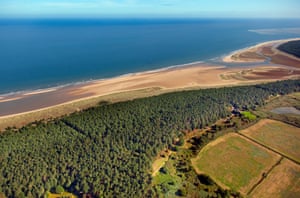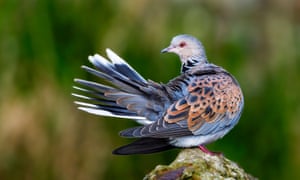Moles are daring to clamber above ground to hunt for worms, oystercatchers are nesting on deserted beaches, and overlooked plants such as ivy-leaved toadflax are gaining new friends.
The shutdown of modern life as we know it is liberating British wildlife to enjoy newly depopulated landscapes. But conservationists say the impact is not all positive, with wildlife crimes going unreported and vital work including monitoring impossible to carry out.
Jake Fiennes, conservation manager of the 9,600-acre Holkham national nature reserve, the biggest in England, said his staff were excited to record what unfolds on the Norfolk beach, salt marsh and grasslands.
“We have annual visitor numbers in excess of one million and suddenly, in the peak of breeding season, they are not going to be here. Nature is just going, ‘Ahhh, it’s all to ourselves now,'” he said.
As at all British nature reserves, public footpaths through Holkham are open but car parks and visitor centres are closed.

Fiennes and his fellow wardens have already noticed more sparrowhawks, stoats and deer on once heavily walked tracks.
“The greatest impact we might see will be on the shorebirds,” said Fiennes. He hopes the shutdown will be a boon to beach-nesting birds including oystercatchers, sandwich terns and the endangered ringed plover.
Last summer, for the first time in living memory, no oystercatchers nested on Holkham beach. Although areas of beach are cordoned off for birds, increases in footfall including dog walkers are thought to be behind the declines there.
If the lockdown is lifted in the middle of bird-nesting season, the impact could be catastrophic, Fiennes said. “All these species nest where they think they are safe – and then we open the gates,” he said.
According to naturalist Matthew Oates, there are parallels with the shutdown of the countryside during the 2001 foot and mouth crisis. “When we move out, obviously nature moves in,” he said. “Dog prints and dog faeces are gone, and there are fox and weasel prints instead.”
Oates believes that people are already appreciating “the gathering quietude”. “One of the positive things that could come out of this is the realisation that machinery noise damages us and damages our minds,” he said. “Without traffic and aeroplane noise, we hear the birds again and the wind. Last night I swear I heard the wings of a tawny owl as it flew over, which I haven’t heard for decades.”
Phoebe Miles at Plantlife has noted a proliferation of sightings of moles above ground near well-walked footpaths. She is also struck by residents of cities such as Bristol, where she lives, newly absorbing their neighbourhood’s nature.

“It’s being with the detail of everyday nature which is so beautiful,” she said. “Yes, you can hear the birds singing because there’s no traffic, but you can also see the detail that’s always been in front of you. There are a lot of very beautiful small plants coming out at this time – ivy-leaved toadflax, wall screw moss, umbrella liverwort, roux-leaved saxifrage – and it’s touching to see children and adults getting drawn into this.”
Ryan Brock
(@RBrock94)Social distancing day 3: went birding around @uniofeastanglia campus and stumbled across this mole foraging above ground! Very cool to witness. pic.twitter.com/FlcYy0C9pH
HS2 is facing accusations from opponents that its destruction of ancient woodlands is going ahead during lockdown so that any potential illegal damage to birds’ nests, for instance, would go unnoticed.
“In some areas, the absence of eyes and ears on the ground might be really problematic, with bird of prey persecution or disturbance of little tern colonies going unseen,” said Martin Harper, global conservation director of the RSPB. The charity has urged members of the public to report any illegal destruction of birds’ nests by HS2 to the police.

Conservation work is also being disrupted. Harper said he feared for schemes such as Operation Turtle Dove, in which farmers provide spring food for turtle doves, one of Britain’s most endangered birds. With supply chains disrupted and “non-essential” work cut, the turtle dove feeding is likely to be curtailed.
While garden nature is set to be better observed than ever, with surges in participation in schemes such as Butterfly Conservation’s garden butterfly survey, conservationists fear the wider wildlife boom will go unrecorded.
Some of the volunteer army of wildlife surveyors who contribute to the Breeding Bird Survey and Plantlife’s species monitoring work are incorporating their recordings into their daily dose of exercise, as permitted under the lockdown conditions, but many risk-averse conservation charities are cancelling monitoring programmes because they are not deemed essential work.
“It’s a mixture of hope and extreme frustration,” said Plantlife’s Jo Jones. “The biggest issue is missing out on the yearly data.”
According to Jones, extremely rare plants such as prostrate perennial knawel could easily be accidentally covered in dumped rubbish or destroyed without regular monitoring. “To understand what these plants are doing, you have to go and watch them and understand if conservation work is helping them or not,” she said.
But Jones is also hopeful that the lockdown will encourage home-schooled children and their parents to notice the wildlife around them. “We could have a re-engagement with nature and plants, and that is for everybody, wherever they live.”